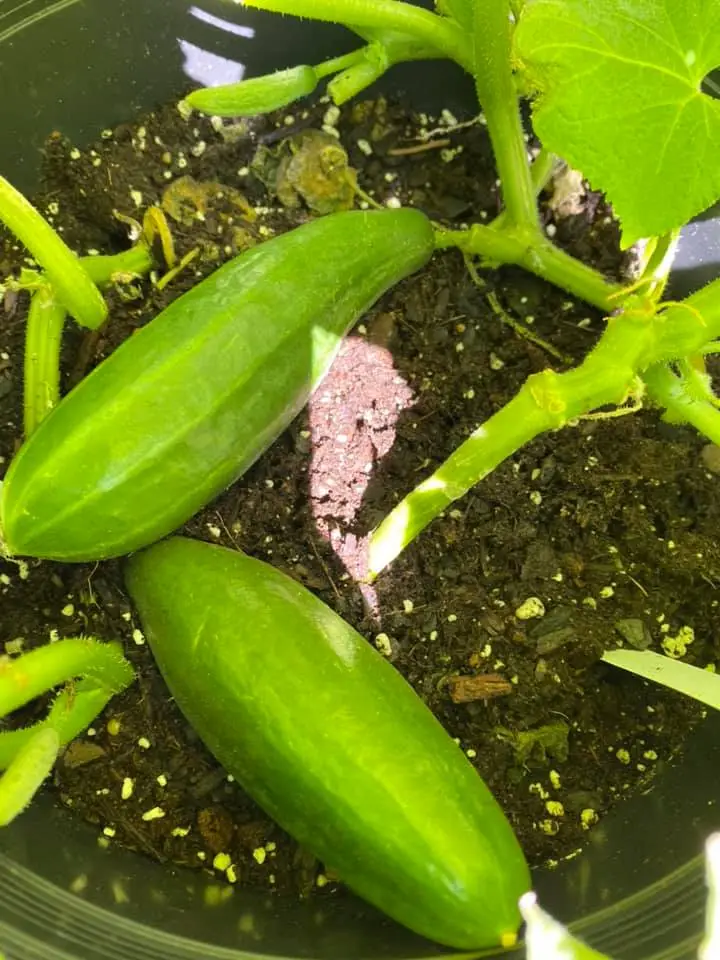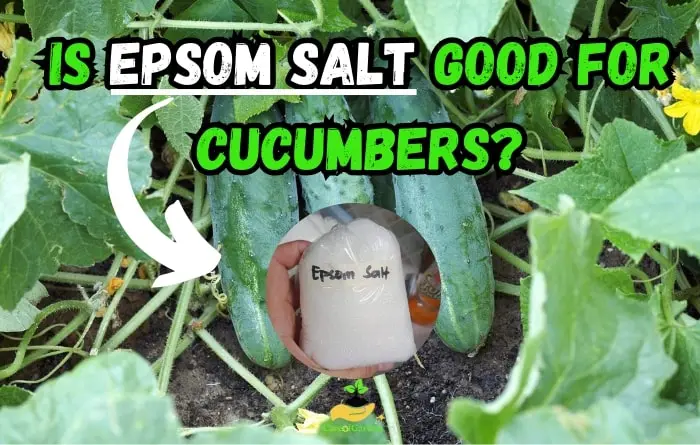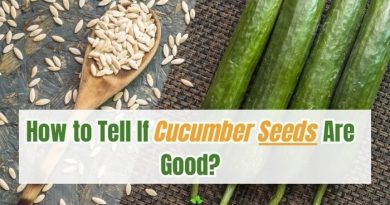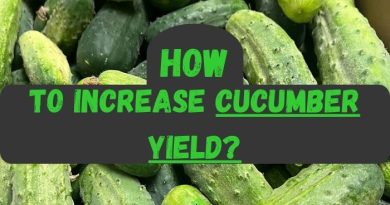Is Epsom Salt Good for Cucumbers? The Secret to Bigger Cucumbers!
Are you looking for a natural way to boost your cucumber crop this season? As an avid gardener, I’ve seen firsthand how Epsom salt can transform these vines from good to great.
In this post, I’ll share my top tips for using magnesium sulfate as a powerful, organic fertilizer to support cucumbers from planting to picking. You’ll discover easy application methods and optimal timing that could be the difference between an average harvest or your best yield yet.
Yes, Epsom salt is good for cucumbers because it provides essential magnesium, which improves photosynthesis and nutrient absorption. This leads to healthier cucumber plants and higher yields while also preventing blossom end rot, a magnesium deficiency that causes brown spots. In short, Epsom salt fertilization boosts cucumber health and productivity in a simple, low-cost way.
Here are some key points to consider when applying Epsom salt to cucumbers:
- Diagnose Nutrient Deficiencies: Before applying Epsom salts to your plants, you should diagnose nutrient deficiencies accurately. Symptoms of magnesium deficiency include yellowing between leaf veins (interveinal chlorosis) and poor fruit development. If your plants exhibit these symptoms, Epsom salts might be beneficial.
- Soil Testing: Conduct a soil test to determine if your soil lacks magnesium. If your soil already has sufficient magnesium levels, adding more through Epsom salts can lead to an imbalance and potential issues.
- Application Rate: When using Epsom salts, a common recommendation is to dissolve 1 to 2 tablespoons in a gallon of water and apply it as a soil drench or foliar spray. This application should be done periodically, not too frequently, as excess magnesium can lead to nutrient imbalances.
- Balanced Fertilization: Remember that magnesium is just one of several essential nutrients. Properly balanced fertilization, including macronutrients (nitrogen, phosphorus, and potassium) and micronutrients, is essential for overall plant health.
- Effect on Cucumber Plants: Epsom salts can benefit cucumber plants if they are truly magnesium deficient. It may enhance green growth and fruit development. However, be cautious, as overuse of Epsom salts can lead to an increased risk of blossom end rot in cucumbers, a disorder linked to calcium deficiency.
- Alternative Solutions: Instead of Epsom salts, consider using dolomitic limestone if your soil is acidic and low in magnesium. It will help raise the pH and provide a slow-release source of magnesium.
Benefits of Epsom Salt for Cucumbers
Using Epsom salt for cucumber plants can have a positive impact on their growth and overall health. Epsom salt, also known as magnesium sulfate, contains high levels of magnesium and sulfur, which are essential nutrients for plant development.
1. Boost Magnesium Levels
As a gardener, I’ve found Epsom salt is extremely effective at boosting the magnesium in my soil. Cucumbers are heavy magnesium consumers, so this mineral is essential for them. With regular applications, I can see a noticeable difference in my plants’ greenness and vigor. Their leaves are a deeper color and they just look healthier overall.
Magnesium is involved in a number of important processes, such as photosynthesis, enzyme activation, and the production of chlorophyll. Magnesium deficiency in plants can lead to stunted growth, yellowing leaves, and poor fruit production.
By boosting magnesium levels, Epsom salt can help improve the overall health and growth of the plant.
2. Increases cucumber yield
Another benefit of Epsom salt for cucumbers is that it can help increase yield. Magnesium is necessary for the production of chlorophyll, which is responsible for the green color of leaves and the production of carbohydrates. By increasing magnesium levels, Epsom salt can help boost the plant’s ability to produce energy, which can lead to higher yields.
Epsom salt makes a big impact on my harvest weights. The vines grow more prolifically with more flowers and fruits set. This season with Epsom salt, I’m averaging at least 3-4 more cucumbers per plant. Doing the math, that adds up to dozens more cucumbers that I can enjoy or share with others.
My cucumbers also fruit earlier and stay productive for longer with Epsom salt applications. The extra magnesium and sulfur seem to put less stress on the plants. They flower profusely from the start and keep pumping out cucumbers until the end. This is great for extending my harvest.
I’m also pleased that Epsom salt helps produce higher yields overall. With more and larger leaves feeding more fruits, I consistently get a bigger haul from the same space. It really maximizes what I can grow in my garden.
3. Improve the Overall Health of Cucumber Plants
As someone who grows cucumbers every year, I’ve found that Epsom salt really helps promote lush, dark green foliage. The magnesium helps chlorophyll production, so the vines stay vibrant and healthy throughout the season.
Using Epsom salt also leads to stronger, more vigorous plant growth. The sulfate allows my cucumbers to take up more nutrients from the soil. I’m always impressed with how robust the vines get compared to when I don’t use it. More leaves mean more energy for the plants.
The magnesium and sulfur in Epsom salt strengthen my cucumber plants internally. Their cell walls are reinforced and photosynthesis runs more smoothly. As a result, the vines are more resilient against pests and diseases.
They withstand heat and drought stress better too. This allows my plants to thrive for their entire lifecycle rather than declining prematurely.
4. Reduced blossom end rot
I used to struggle with this fungal disease, but Epsom salt has nearly eliminated it. The fruits develop fully with adequate calcium translocation. They stay firm and flavorful right until harvest. No more cutting into rotten cucumbers!
BER occurs when calcium and magnesium levels fluctuate, disrupting nutrient uptake. Epsom salt buffers against this, maintaining proper ratios to prevent lesions from forming on developing cucumbers.
Adequate magnesium levels, obtained by using Epsom salt, play a significant role in preventing this problem. Blossom end rot is often a sign of calcium deficiency, and magnesium aids in the uptake of calcium.
By ensuring that my cucumber plants have the right balance of nutrients, including calcium and magnesium, I’ve significantly reduced the occurrence of blossom end rot. Regular watering to maintain even moisture levels is also key in preventing this issue.
5. Hardnes cucumber
Magnesium helps cell walls retain turgor pressure and resist cracking under challenging conditions. Epsom salt hardens plants so they stay productive even during heat waves, cold snaps, or periods of inadequate rain or irrigation.
The magnesium and sulfur in Epsom salt stimulate root development and growth. Stronger root systems are able to support larger, more productive cucumber plants above ground.
6. Cost-Effective Solution
Unlike expensive store-bought formulas, Epsom salt is a cheap, organic fertilizer source readily available anywhere. A $5 box of Epsom salt can provide months of fertilizer value through multiple applications. It dissolves and feeds plants without synthetic chemicals or heavy metals found in some commercial products.
Overall, using Epsom salt can be a great way to boost the growth and health of cucumber plants. By providing essential nutrients like magnesium and sulfur, Epsom salt can help improve photosynthesis, increase yield, and promote healthy plants.
As always, it is important to use Epsom salt in moderation and follow the instructions carefully to avoid any negative effects on your plants.
How to Use Epsom Salt on Cucumber Plants

Using Epsom salt on cucumbers can be a bit of a mixed bag. Epsom salt is essentially magnesium sulfate, and it’s only beneficial if your soil is deficient in magnesium or sulfur. If your soil already has an adequate supply of these nutrients, adding Epsom salt may not provide any noticeable benefits.
In most cases, I prefer to get a soil test done to determine if my soil truly lacks magnesium or sulfur. If the test confirms the deficiency, applying Epsom salt can be helpful. However, keep in mind that you don’t need much of it. Overuse can lead to magnesium buildup in the soil, which isn’t ideal either.
So, whether to use Epsom salt on cucumbers or not depends on your specific soil conditions. If you’re unsure, I’d recommend conducting a soil test to get a better understanding of your soil’s nutrient needs.
| Cucumber Growth Stage | Epsom Salt Quantity |
|---|---|
| Seedling/Young Plants (1-4 weeks) | 1/2 teaspoon epsom salt per plant |
| Vegative Growth (4-8 weeks) | 1 teaspoon epsom salt per plant |
| Flowering and Fruit Set (8-12 weeks) | 2 teaspoons epsom salt per plant |
| Fruit Expansion (12-16 weeks) | 1 tablespoon epsom salt per plant |
| Late Fruiting (16-20 weeks) | 2 tablespoons epsom salt per plant |
https://careofgarden.com/cucumber-growth-stages/
Materials Needed:
- Epsom salt
- Measuring spoon or scale
- Watering can or spray bottle
- Cucumber plants
Timing:
- Start 4-6 weeks after transplanting cucumber seedlings or direct sowing seeds
- Reapply every 2-4 weeks during the main growing season, until 4-6 weeks before the first fall frost
Dilution Ratio:
- Foliar application (spray bottle): 1 tablespoon Epsom salt per 1 gallon water
- Soil drench: 2 tablespoons Epsom salt per 1 gallon water
How to Apply Epsom Salt to Cucumber Plants:
- Fill the watering can/spray bottle with water
- Measure the appropriate amount of Epsom salt based on the dilution ratio
- Stir vigorously until all Epsom salt is dissolved
- For spray application:
- Spray foliage in the morning or evening until lightly moistened
- For soil drenching:
- Slowly pour solution within 6-12 inches of plant stems
- Water in well after application
- Reapply every 2-4 weeks as new growth occurs
- Mark the calendar to remember the application schedule
- Stop 4-6 weeks before fall frost to allow magnesium absorption
- Monitor plants and adjust method/amount if signs of deficiency persist
Methods to Apply Epsom Salt on Cucumber Plants
| Methods to Apply Epsom Salt on Cucumber Plants | Recommended Frequency |
|---|---|
| 1.Watering | Once every 4 to 5 weeks |
| 2. Foliar Spray | Once a month |
| 3. Watering | During midseason |
| 4. Soil Drench | If plants show magnesium deficiency signs |
| 5. Homemade Fertilizer | Once a month |
I know there are several ways I can apply Epsom salt to my cucumber plants to provide them with optimal nutrition for healthy growth:
- Watering: One method I use is dissolving Epsom salt in water and watering with this solution. I’ll mix 2-3 tablespoons of Epsom salt per gallon of water and use it to water my cucumbers once every 4-5 weeks. This allows the plants to take up the magnesium and sulfur through their roots, aiding nutrient absorption and metabolism. I make sure to thoroughly soak the soil so the solution reaches the root zone.
- Foliar Spray: Another approach is applying Epsom salt as a foliar spray. I mix 1 tablespoon per gallon of water and spray this on the leaves about once a month. The nutrients can be directly absorbed through the foliage, quickly boosting magnesium and sulfur levels. I spray in the morning or evening to avoid heat stress on the plants.
- Sidedressing: In addition to watering and spraying, I also sidedress Epsom salt. This involves sprinkling 2-3 tablespoons around each plant midseason. The slow release provides a steady supply of magnesium and sulfur over time. Sidedressing works well for larger, established cucumber plants that need an extra nutrient boost.
- Soil Drench: If my cucumber plants start showing signs of magnesium deficiency, like yellowing leaves, I’ll use an Epsom salt soil drench to help them out. I’ll mix two tablespoons of Epsom salt into a gallon of water. Then I carefully pour the solution onto the soil surrounding each plant. This allows my cucumbers to absorb the necessary nutrients through their roots for healthy growth.
- Homemade Fertilizer: Instead of store-bought fertilizer, I also like to make my own organic mixture using Epsom salt. I combine one tablespoon each of Epsom salt, baking powder, and ammonia into a gallon of water. Once a month I use this homemade fertilizer solution to water my cucumber plants. The blend of ingredients provides balanced nutrition to promote vigorous vines and productivity all season long. The cucumbers respond really well to this natural fertilizer that I take the time to craft myself.
When and How Often to Apply Epsom Salt on Cucumber
From my gardening experience, I’ve found the best time to apply Epsom salt to cucumbers is during the main growing season when the plants are actively vegetative. This ensures they have enough magnesium and sulfur to support strong growth.
In the early stages after transplanting seedlings, I don’t add any Epsom salt for about 4 weeks. The young plants need time to establish their root systems first before taking up extra nutrients.
Once the vines start running, that’s when I begin my Epsom salt regimen. I usually do a light application by watering every 4-5 weeks with a 2-3 tablespoon per gallon solution. This provides a steady supply of nutrients through their roots as they grow.
In between waterings, I’ll also do a foliar spray using the same concentration once a month. Spraying the leaves gives the plants an extra boost that seems to really green them up.
Around mid-season when the vines are long and fruiting heavily, that’s when I side dress with Epsom salt too. Sprinkling some around the base helps sustain the big plants through pollination and harvest time.
Towards the end of the season, as growth slows, I scale back Epsom salt applications since the plants don’t need as much. By then, with regular use all season, my cucumbers have gotten plenty of magnesium and sulfur to produce a bountiful crop.
How Much Epsom Salt for Cucumbers?
| Application Method | Timing | Quantity |
|---|---|---|
| Watering | Mid-season (4-5 weeks after planting) | 2-3 tablespoons of Epsom salt in a gallon of water |
| Foliar Spray | Mid-season (4-5 weeks after planting) | 1 tablespoon of Epsom salt in a gallon of water |
| Sidedressing | Mid-season (4-5 weeks after planting) | 2-3 tablespoons of Epsom salt around the base of the plants |
Here is my recommendation on how much Epsom salt to use on cucumbers:
- When I water my cucumber plants with Epsom salt, I use a ratio of 2-3 tablespoons per gallon of water. Any more than that seems unnecessary and could potentially stress the plants.
- For foliar spraying, I found that 1 tablespoon per gallon strikes the right balance. Too much solution on the leaves may cause burning in strong sunlight.
- As for sidedressing, I gently sprinkle around 2-3 tablespoons per plant when they’re mid-sized. That provides plenty of minerals without overdoing it.
If a plant appears to have a magnesium deficiency with yellowing leaves, I’ll do a soil drench with the same 2 tablespoons per gallon concentration and pour it all around the base.
When mixing my own organic fertilizer with Epsom salt, baking powder and ammonia, I found 1 tablespoon of each ingredient per gallon of water works well. The cucumbers respond very positively to this light dose each month without any burning or toxicity issues.
In general, I’ve learned cucumbers are quite tolerant of Epsom salt so there’s no need to skimp, but going over 3 tablespoons per gallon or plant seems to give diminishing returns without additional benefits for the effort. My cucumbers have always thrived with these moderate application rates.
Precautions and Tips for Using Epsom Salt
While Epsom salt can be beneficial for cucumber plants, it’s crucial to exercise caution and follow certain guidelines to avoid any negative effects.
Here are some precautions and tips to keep in mind when using Epsom salt on your cucumber plants:
- Do not overuse: It’s important to remember that Epsom salt should be used in moderation. Overuse can lead to nutrient imbalances and damage to the plants. Applying Epsom salt once in the mid-season, rather than weekly, is generally recommended.
- Proper application methods: Epsom salt can be applied through watering, foliar spray, or sidedressing. Watering with a solution of Epsom salt once every 4-5 weeks or applying it as a foliar spray once a month can help provide the deficient nutrients to the plants. Sidedressing with 2-3 tablespoons of Epsom salt around the base of the plants during the midseason can also promote growth.
- Don’t rely solely on Epsom salt: While Epsom salt can provide a boost of magnesium and sulfur, it should not replace regular fertilization practices. It’s important to continue using a balanced fertilizer to ensure your cucumber plants receive all the necessary nutrients for optimal growth.
- Replace older plants: If your cucumber plants are facing issues with insects or diseases, it’s recommended to start new cucumber transplants mid-July. This can help ensure healthier and more productive plants.
- Maintain proper watering: Consistent and proper watering is essential for cucumber plants. Adequate water supply throughout the growing season can support healthy growth and prevent stress on the plants.
Please make sure to follow these precautions and tips so you can make the most of Epsom salt’s benefits for your cucumber plants while avoiding any potential negative effects.
Conclusion
In conclusion, Epsom salt can be a valuable tool in promoting the growth and health of cucumber plants if used correctly and in moderation. Cucumbers, like other plants such as tomatoes and roses, can benefit from the additional supply of magnesium and sulfur that Epsom salt provides. The high magnesium content in Epsom salt aids in chlorophyll production, which is essential for photosynthesis and overall plant growth.
While Epsom salt can be beneficial, it should not replace regular fertilization practices. It is crucial to maintain a balance and not solely rely on Epsom salt for all nutrient needs. Starting new cucumber transplants in mid-July to replace older, insect-plagued, or diseased plants is recommended. Additionally, consistent watering throughout the growing season is vital for the successful cultivation of cucumbers.
Frequently Asked Questions
Epsom salt can provide a boost of magnesium, promoting growth and addressing nutrient deficiencies in cucumber plants.
Epsom salt can be applied through watering, foliar spray, or sidedressing.
Caution should be exercised to avoid overuse of Epsom salt, as it can cause nutrient imbalances and damage to the plants. Epsom salt should not replace regular fertilization practices.




